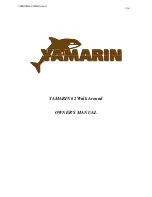
Section 10
10-8
LAUNCHING
Before launching, inspect the launch ramp for any problems that may hinder
launching or make launching unsafe. Ramps can be slick and dangerous to drive
or walk on, and may have unseen drop-offs beneath the water that would pose a
safety hazard. Always be aware of water conditions and the effects of the wind
when launching.
Before launching your boat, inspect the boat and trailer for damage. Do not launch
if you detect damage or find that the engine or propeller is not in good operating
condition. Have any repairs made before launching.
Use courtesy when preparing the boat for launching by doing so away from the
ramp on level ground before proceeding to the launch ramp.
When launching your boat on the trailer, have two or more people assist you.
Since all launches are different, the following procedures are intended as
guidelines only:
• Verify that your vehicle's brakes, including the parking brake, are in proper
working order.
• Make sure the trailer is securely fastened to the vehicle.
• Remove the boat cover, if equipped.
• Check that the bilge drain plug is in place and all other plugs that allow water to
leak into the boat are in place.
• Remove all tie-downs from the boat.
• Attach the bow and stern docking lines.
• Attach boat fenders if necessary.
• Disconnect the trailer lights from the car if applicable, some trailers using surge
brakes require the 5-pin harness connected to the vehicle to allow the trailer to
be backed-up.
• Make sure the bow winch and strap are securely locked and fastened.
• Make sure all required documentation and safety equipment are on-board.
• Verify that batteries are fully charged and in good condition.
• Check fuel level; add fuel if necessary.
• Always launch with the help of another person.
• Make sure there is no one on the ramp behind the boat.
• Keep the trailer/vehicle combination as straight as possible and at 90 degrees to
the shoreline.
• Back slowly down the ramp until the transom of the boat is a few inches under
water; then stop the vehicle.
• Stop the vehicle and shift into PARK (automatic transmission) or REVERSE
(manual transmission). Apply the brakes and/or parking brake. If possible, use
wheel blocks.
• Position the mooring lines within reach of the dock.
Summary of Contents for Fi21
Page 1: ...Centurion_Cover_2019_Layout 1 10 24 2018 9 48 AM Page 1...
Page 3: ...This Page Intentionally Left Blank...
Page 7: ...iv This Page Intentionally Left Blank...
Page 17: ...Section 1 1 10 This Page Intentionally Left Blank...
Page 27: ...Section 2 2 10 This Page Intentionally Left Blank...
Page 48: ...Safety 3 21 Figure 3 4 Figure 3 4 CNTRN 0050B A...
Page 68: ...Safety 3 41 Figure 3 10Centurion Ri237 Figure 3 13 Figure 3 11Centurion Ri217 Figure 3 14...
Page 69: ...Section 3 3 42 Figure 3 12Centurion Fi25 Figure 3 15 Figure 3 13Centurion Fi23 Figure 3 16...
Page 70: ...Safety 3 43 Figure 3 14Centurion Fi21 Figure 3 17...
Page 71: ...Section 3 3 44 This Page Intentionally Left Blank...
Page 131: ...Section 8 8 24 Fi23 Ballast Tank Locations Figure 8 22 Fi21 Ballast Tank Locations Figure 8 23...
Page 165: ...Section 10 10 10 This Page Intentionally Left Blank...
















































